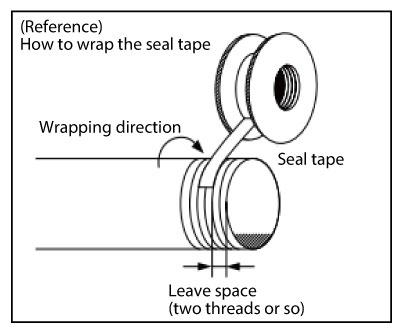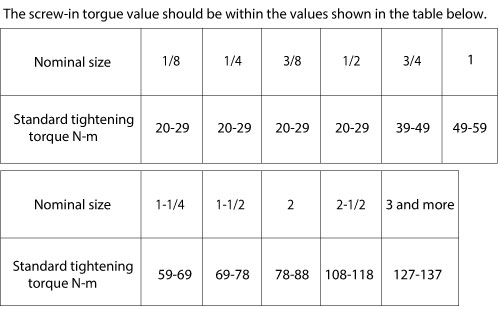Ball Valves Questions
External Leakage
- Gate Valves
- Globe Valves
- Ball Valves
- Fluid leaks from the gland.
-
Check the packing retaining nut, gland bolts and nuts for looseness.
It is possible to prevent leakage by retightening them before use.● For valves with packing retaining nut design
Be sure to depressurize the inside of the valve and confirm that the pressure has dropped to the atmospheric level.
Retighten the nut with a spanner or wrench to the extent that the handle operation torque does not become to high.● For valves with gland nuts / bolts design
Be sure to depressurize the inside of the valve and confirm that the pressure has dropped to the atmospheric level.
Evenly tighten the gland nuts with a spanner or wrench so that the gland flange is installed parallel to the pipe.The gland area is sealed by the packing with pressure applied to its surface.
If the packing is kept under the surface pressure for a certain period of time, its shape is deformed with time.
As a result, stress relaxation takes place on the packing, and the nuts need to be retightened.
Applicable product
- Gate Valves
- Globe Valves
- Check Valves
- Ball Valves
- Fluid leaks from the screwed area.
-
When connecting the valve to the pipe, wrap PTFE seal around the male threads or apply a thin layer of suitable liquid sealant. Do not use a tool and screw the pipe manually to insert it to the deepest position of the valve bore, while carefully checking the feel for the right fit of the threads.
Choose and used an appropriate seal tape suitable to the fluid used, working temperature and other parameters. Make sure that the seal material does not enter inside the valve.
When wrapping the tape, it should be wrapped two or three times in the same direction as the thread-tightening direction.
If the tape is wrapped in the opposite direction, the pipe may be loosened during installation, leading to leakage.
Applicable product
- Gate Valves
- Globe Valves
- Check Valves
- Ball Valves
- The valve body was cracked, causing external leakage.
-
When the residual water in the pipe or valve is frozen, the product may be damaged and external leakage may occur.
In an environment where freezing is expected, remove the residual water from the pipe or implement the appropriate anti-freezing measures, such as thermal insulation or heater, to the valve and pipeline.
Applicable product
Excessive Operation Torque
- Gate Valves
- Globe Valves
- Ball Valves
- The valve operation torque is abnormally high.
-
① If the packing retaining nut is tightened too tightly, the handle operation torque becomes too high.
Loosen the packing retaining nut while making sure that no leakage occurs.
Be sure to depressurize the inside of the valve before loosening the nut.② When the valve is installed to the pipe, apply an appropriate tool to the hexagonal piping connection port of the body located on the pipe side. The valve may be deformed when the valve body is clamped with a vice or pipe wrench for connecting to the pipe.
③ The pipe or fitting ends may hit the wall on the back of the body seat if they are excessively inserted to the valve bore. Such an installation may deform the body seat.
Copper materials are weaker in mechanical strength than steels, so if steel fittings are overly tightened into the bore of copper valve, this may deform the valve body.
When steel fittings are threaded into the copper valve bore, refer to the tightening torques shown in the table below before performing the work.

Applicable product
Internal Leakage
- Gate Valves
- Globe Valves
- Check Valves
- Ball Valves
- Although the valve is fully closed, the seat still leaks.
-
① Foreign particles may be caught on the seat surface.
After the installation of the valve, the inside of the pipeline should be flushed with the valve fully opened to remove the foreign particles.② If the valve and the pipe are made of different metals, a cell may be formed because of the potential difference between the metals. This may cause galvanic corrosion inside the valve, leading to the possibility that the handle gets stuck or seat leakage occurs. Use the same material for the valve and the pipes when they are used in the same pipeline.
Applicable product
Improper Piping
- Gate Valves
- Globe Valves
- Check Valves
- Ball Valves
- The valve cannot be screwed into the piping.
-
① The pipe threads may be deformed.
The threads may be deformed when the valve is attached to the pipes with a pipe wrench or vice. Use an appropriate tool, such as a spanner, to retighten the valve with the proper tightening torque.
When installing the valve to the pipe, apply an appropriate tool to the pipe connection area of the valve body. Place the tool to the area near the side attached to the pipe.② Check that the pipe is not inserted obliquely.
Confirm that the pipe threads are machined in accordance with the thread standards that meet the product used..


Applicable product
Oil Leakage
- Gate Valves
- Globe Valves
- Check Valves
- Ball Valves
- Butterfly Valves
- When I tried to install the valve, oil came out.
-
For our standard products, oil and grease are applied for the purposes of lubrication and rust prevention.
Contact us in case oil-free products are required.
Applicable product
